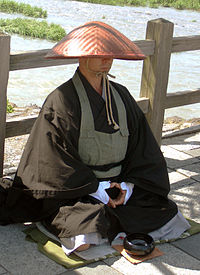
Sōtō Zen (Ch. Caodong), or Sotoshu (the Sōtō school) as it is known in Japan, represents one of the largest sects of Buddhism in Japan (second only to Pure Land Buddhism). As of 2006, the Sotoshu has 14,702 temples in Japan.[1] According to William M. Bodiford, "Today the Sōtō Zen school constitutes the largest single religious denomination in Japan. In this statement, one must emphasize the word 'single.' Pure Land Buddhism boasts a great number of temples—about 30,000—but they are divided among some ten (or more) separate legal entities, the largest of which (Jōdo Shinshū Honganjiha) commands the allegiance of about 10,0000 temples. Sōtō Zen, in contrast, consists of more than 14,000 temples and monasteries, all of which coexist within a single institutional structure."[2] In addition to the sect's large presence in Japan, Soto Zen is also the most common form of Zen Buddhism practiced in Western countries.[3] The sect was first established as the Caodong sect during the Tang Dynasty in China by Dongshan Liangjie in the 9th century, which Dogen Zenji then brought to Japan in the 13th century. It should be noted, however, that Dogen is remembered today as the co-patriarch of Sōtō Zen in Japan along with Keizan Jōkin.[2][4] One of the signature features of this school is found in its practice of shikantaza, a particular approach to zazen which is sometimes referred to as "just sitting" or "silent illumination."[5] Historically speaking—Soto Zen was often termed "farmer Zen" (derogatory term) due to its mass appeal among "common people", while the Rinzai school was often called "samurai Zen" due to the many samurai among its ranks.[6][7] The latter term for the Rinzai can be somewhat misleading, however, as the Soto school also had samurai amidst its rosters.[8]
The two head temples of the Sōtō sect are Eiheiji and Sōji-ji. While Eiheiji owes its existence to Dogen, throughout history this head temple has had significantly less sub-temple affiliates than the Sōji-ji. During the Tokugawa period, Eiheiji had approximately 1,300 affiliate temples compared to Sōji-ji's 16,200. Furthermore, out of the more than 14,000 temples of the Soto sect today—13,850 of those identify themselves as affiliates of Sōji-ji. Additionally, most of the some 148 temples that are affiliates of Eiheiji today are only minor temples located in Hokkaido—founded during a period of colonization during the Meiji period. Therefore, it is often said that Eiheiji is a head temple only in the sense that it is "head of all Sōtō dharma lineages."[2]